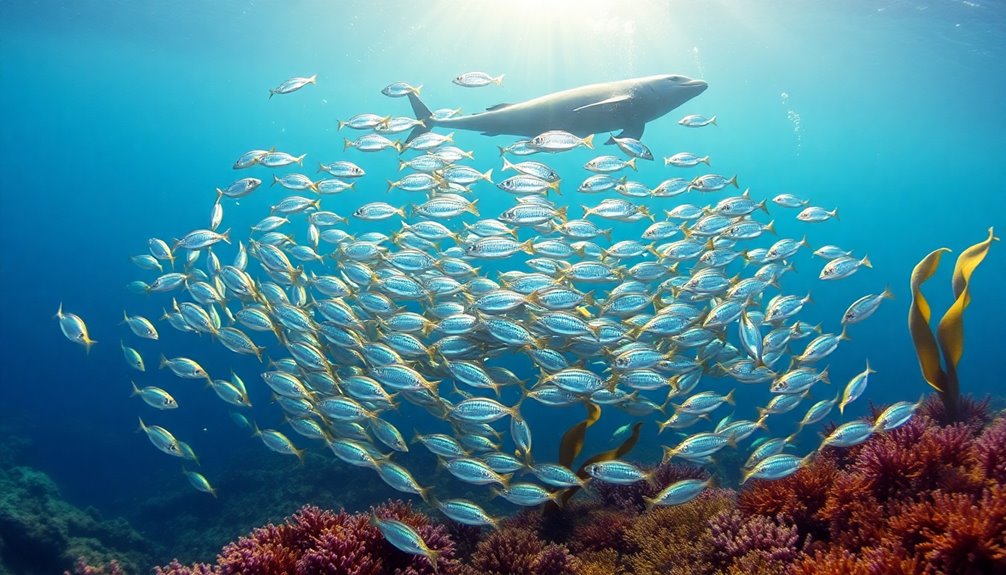Forage fish, like sardines and anchovies, play an important role in marine ecosystems. These tiny swimmers serve as a primary food source for larger predators, including tuna and seabirds. By supporting the food web, they help maintain biodiversity and ecosystem health. Unfortunately, overfishing and climate change threaten their populations, which can lead to devastating effects on marine life. Economically, forage fish contribute billions through fisheries while also promoting coastal community livelihoods. Sustainable management practices are essential to protect both these fish and the ocean's balance. Keep exploring, and you'll discover even more about their significant contributions and current challenges.
Key Takeaways
- Forage fish are essential for marine food webs, serving as primary food sources for larger predators like tuna and seabirds.
- They contribute to ecosystem health by aiding in water filtration and nitrogen removal, promoting biodiversity.
- Overfishing of forage fish leads to population declines, threatening marine mammals and seabird species reliant on them.
- The economic value of forage fish is significant, with their ecological worth exceeding their direct catch value when left in the ocean.
- Climate change poses additional challenges, as it affects plankton availability, which is crucial for forage fish survival and overall marine health.
Definition of Forage Fish
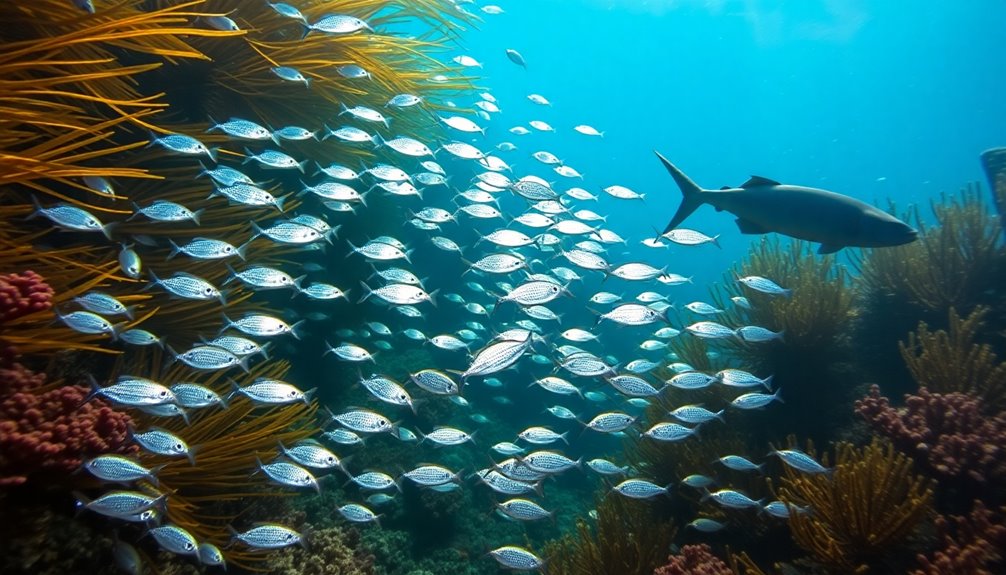
Forage fish, such as sardines, anchovies, and krill, are small pelagic species that primarily feed on plankton and other tiny organisms in the ocean's pelagic zone. These fish are integral components of marine ecosystems, acting as a significant food source for larger predators like tuna, swordfish, and humpback whales.
By consuming plankton, forage fish facilitate energy transfer from lower trophic levels to higher-level predator populations, effectively connecting the entire food web. Their abundance and role in the food chain make forage fish essential for maintaining biodiversity within marine environments.
When predator populations depend on them for sustenance, the balance of the ecosystem is preserved. In fact, the global fishing catch of forage fish accounts for over a third of the total marine fish catch, underscoring their importance both ecologically and economically.
Furthermore, the presence of healthy forage fish populations is an indicator of ecosystem stability. As they continue to sustain larger species, their conservation becomes critical to guarantee the overall health of marine ecosystems.
Recognizing the definition and role of forage fish is the first step toward understanding their importance in our oceans.
Ecological Importance
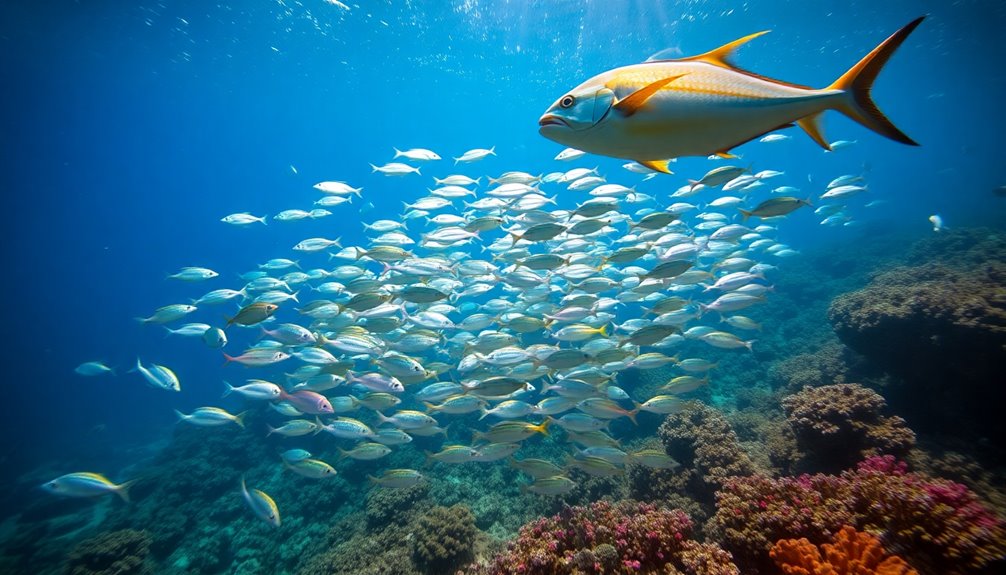
In the vast marine ecosystem, forage fish play a significant role as a primary food source for larger animals like tuna, seabirds, and marine mammals. These small but essential fish, such as sardines and anchovies, are key components of the marine food web. Healthy populations of forage fish not only sustain these predators but also contribute to overall marine biodiversity.
Without adequate numbers of forage fish, the delicate balance of marine ecosystems faces serious ecological consequences. For instance, declines in forage fish populations can lead to reduced seabird populations, as many of these birds rely heavily on them for sustenance. Additionally, the absence of these fish can result in starving marine mammals, such as sea lions, which depend on the same food source.
Beyond being a direct food source, forage fish also promote ecosystem health by aiding in water filtration and nitrogen removal. These processes are essential for maintaining clean and productive marine environments.
Economic Impact
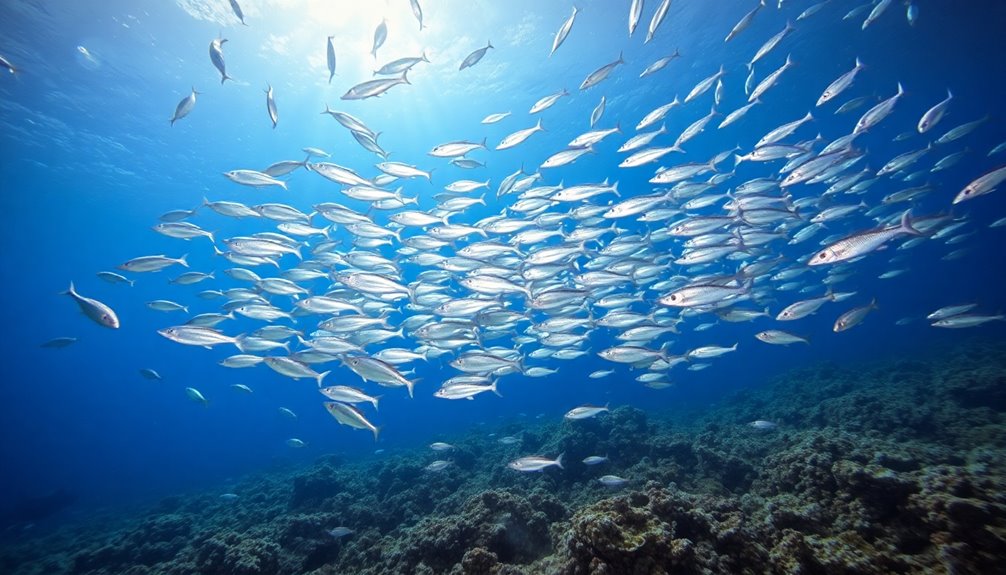
When you think about forage fish, consider their direct catch value of around $5.6 billion, which highlights their role as a food source.
However, their true economic worth lies in the ecosystem services they provide, supporting not just marine life but also industries like wildlife tourism.
As demand increases, it's essential to focus on sustainable fisheries economics to guarantee these valuable fish continue to thrive.
Direct Catch Value
The direct catch value of forage fish stands at an impressive $5.6 billion, underscoring their significance in commercial fisheries. These tiny swimmers play a critical role in the economy, not just for their immediate value but also for their impact on larger fish populations.
Here are some key points to reflect on:
- Fish Meal Production: Approximately 90% of the global forage fish catch is processed into fish meal, essential for aquaculture, livestock, and pet food industries.
- Sustaining Larger Species: Forage fish, like menhaden and sardines, are essential for sustaining larger fish populations, which are important for both recreational and commercial fishing.
- Economic Assessments: While the direct catch value is significant, assessments show that forage fish have an ecological worth of about $11.3 billion when left in the ocean.
- Need for Sustainable Management: The heavy reliance on forage fish for fish meal production highlights the urgent need for sustainable management practices to guarantee the long-term viability of both forage fish fisheries and the marine ecosystems they support.
Recognizing this direct catch value not only benefits the economy but also emphasizes the importance of maintaining healthy marine ecosystems.
Ecosystem Services Valuation
Forage fish contribute greatly to the economy, with their ecological value estimated at around $11.3 billion when left in the ocean. This value highlights the significance of sustainable management practices.
While the direct catch value of forage fish is about $5.6 billion, this pales in comparison to the broader ecosystem services they provide, such as supporting marine biodiversity and predator populations.
Forage fish populations play an essential role in maintaining balanced marine ecosystems. At least one-third of their biomass is critical for healthy seabird populations, demonstrating their integral role in the food web.
However, the increasing demand for forage fish, particularly for fish meal and industrial uses, leads to overfishing, disrupting these vital ecosystem services.
To safeguard marine ecosystems and the economies reliant on them, we must prioritize sustainable management of forage fish. By doing so, you can help guarantee that these tiny swimmers continue to provide invaluable benefits, not just for commercial fisheries, but for the entire marine environment.
Protecting forage fish is key to maintaining the delicate balance of marine biodiversity and securing the future of our oceans.
Sustainable Fisheries Economics
Sustainable fisheries economics hinges on recognizing the broader economic impacts of forage fish beyond their immediate commercial value. While the direct catch of forage fish is estimated at $5.6 billion, their untouched contribution to marine ecosystems is approximately $11.3 billion. This highlights their significance in promoting a healthy ocean environment.
Here are four key points to reflect on:
- Biodiversity Support: Forage fish are essential for sustaining seabird populations, illustrating their indirect economic benefits through enhanced biodiversity.
- Commercial Fisheries: Healthy forage fish populations support robust commercial fisheries, ensuring long-term economic viability for coastal communities.
- Sustainable Management: Implementing sustainable management practices protects forage fish, benefiting both the economy and marine life.
- Precautionary Approach: Approaches like those by the Pacific Fisheries Management Council emphasize the need for caution in harvesting, ensuring forage fish populations remain stable.
Additionally, research indicates that early exposure to STEM education can help foster future generations that prioritize sustainable practices in their industries.
Overfishing Risks
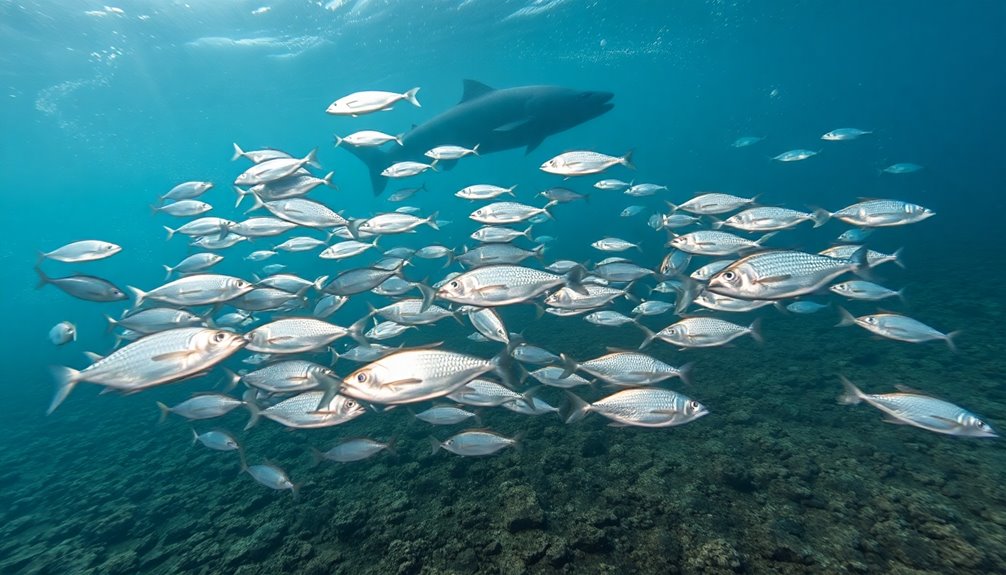
Overfishing risks are a serious concern for forage fish populations, and you need to recognize how this can lead to significant declines.
When these fish disappear, it disrupts the entire ecosystem, affecting larger predators and the biodiversity they support.
Understanding these risks is essential for maintaining the health of our oceans.
Population Declines
The decline of forage fish populations poses a serious threat to marine ecosystems, primarily driven by overfishing practices. When you regard that around 90% of global forage fish catch, like sardines and anchovies, gets processed into fish meal, it's clear that unsustainable fishing is a major issue.
Natural fluctuations in their populations complicate this picture, making it hard to assess their vulnerability.
Here are some critical points to reflect on:
- Cascading Effects: Reducing forage fish can lead to declines in predator species, affecting marine mammals and seabirds.
- Historical Evidence: The collapse of sardine populations in Monterey Bay during the 1950s shows the long-term impacts of overfishing combined with environmental changes.
- Management Responses: The Pacific Fishery Management Council has cut fishing levels in response to dwindling sardine stocks.
- Need for Precautionary Management: Implementing precautionary management in forage fish fisheries is essential to prevent further population declines.
Without careful management, the future of these tiny swimmers—and the larger marine ecosystem they support—remains at risk.
Ecosystem Disruption
Forage fish serve as a critical link in the marine food web, and their decline threatens the entire ecosystem. When you overfish these small but essential species, you risk significant population declines that ripple through marine life.
Larger predator species, like seabirds and marine mammals, depend on forage fish for sustenance. Without them, food webs become unstable, leading to starvation and decreased biodiversity.
Take the Pacific sardine as an example. After experiencing a notable collapse due to overfishing and environmental variability, commercial fishing was banned from 1967 to 1986. This situation illustrates the dire consequences of excessive fishing pressure, as about 90% of the global forage fish catch is processed into fish meal, which further intensifies the risks to these populations.
Research shows that when forage fish populations decline, seabird numbers drop, and marine mammals, such as sea lion pups, face starvation.
To mitigate ecosystem disruption, we need effective ecosystem-based management plans. These plans aim to prevent overfishing while ensuring sufficient forage fish biomass is maintained, ultimately supporting the health of predator species and the overall marine environment.
Management Strategies
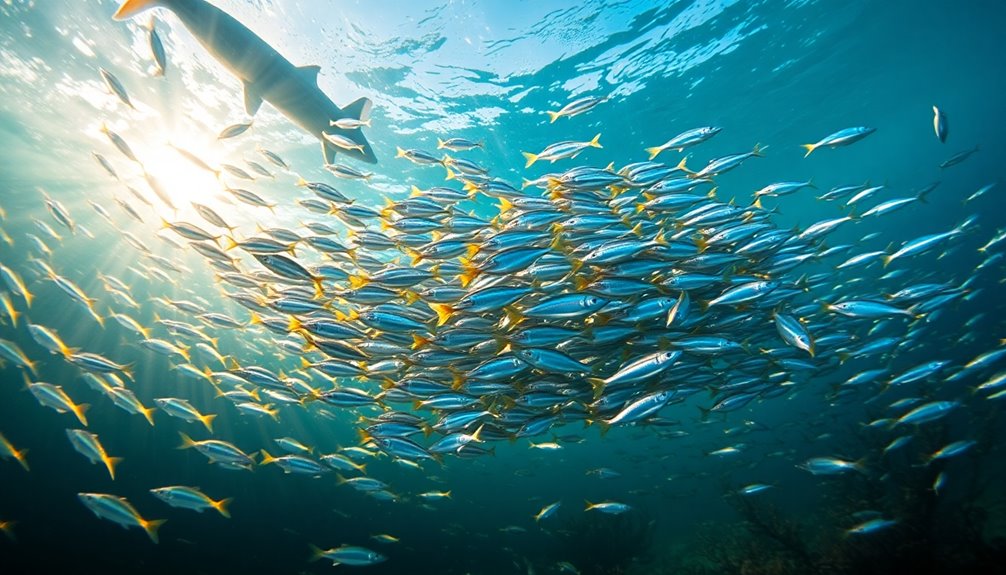
Addressing the management of forage fish is essential for maintaining healthy marine ecosystems. While current practices are limited, several strategies can help close the gaps in sustainability efforts. For example, the Pacific Fisheries Management Council has introduced precautionary management strategies, ensuring that new fisheries must demonstrate no harm to the ecosystem before they're established.
Here are four key management strategies to evaluate:
- Ecosystem-based management: Prioritize plans that assess the complex roles forage fish play, rather than focusing solely on individual species.
- Catch limits: Follow the recommendations from the Lenfest Forage Fish Task Force to halve forage fish catch rates, ensuring populations remain robust.
- Minimum biomass requirements: Implement policies to double the minimum necessary amounts of forage fish in ecosystems, maintaining ecological balance.
- Broader ecological considerations: Encourage commissions like the Atlantic States Marine Fisheries Commission to adopt ecosystem-based approaches, reflecting the importance of forage fish like menhaden.
Case Studies
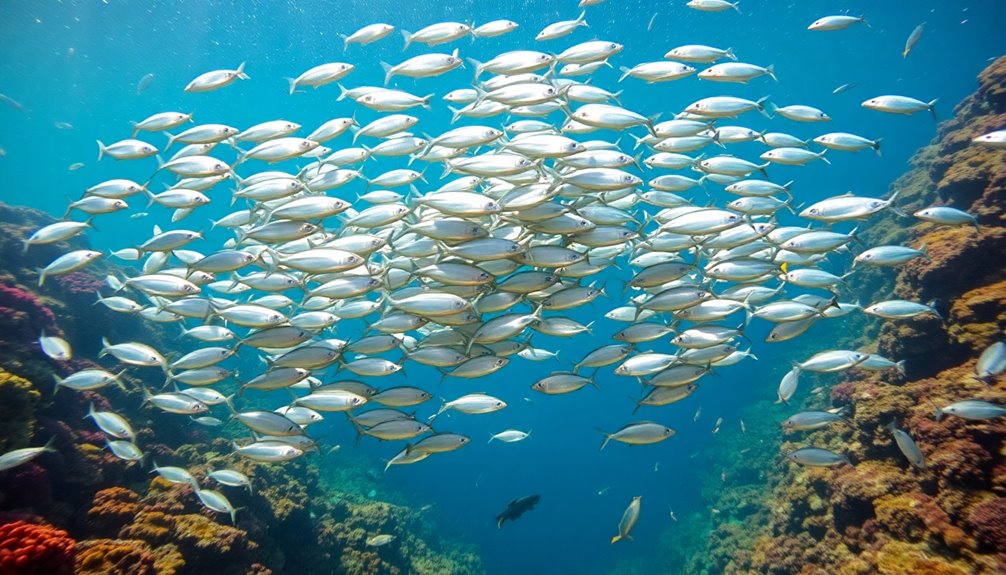
Several case studies illustrate the critical importance of managing forage fish populations effectively. The collapse of Pacific sardine populations in Monterey Bay during the early 1950s serves as a stark reminder of the consequences of overfishing and climate variability. This decline led to a fishing ban lasting from 1967 to 1986, highlighting how unsustainable practices can disrupt the entire ecosystem.
In South America, the anchoveta fishery, the largest globally, has been primarily reduced for non-human consumption, underscoring the significant role forage fish play in commercial fisheries. A 2012 study revealed that reducing the catch of forage fish is essential to protect various predator species, emphasizing ecological interdependence.
Moreover, the natural population fluctuations of Pacific sardines before human intervention complicate our understanding of overfishing impacts. This complexity necessitates sustainable management practices.
The 2017 Free et al. study further challenged assumptions by showing that forage fish abundance rarely impacts predator productivity, indicating a more nuanced relationship between these small swimmers and their larger counterparts.
These case studies underscore that effective management of forage fish is vital for maintaining healthy marine ecosystems.
Future Challenges
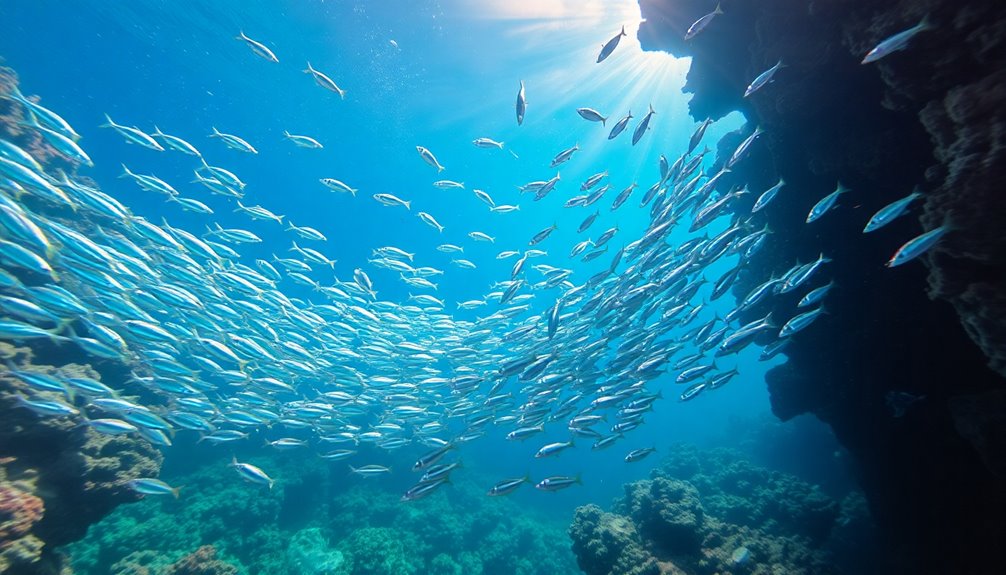
The future of forage fish is increasingly precarious due to mounting threats from overfishing and climate change. With around 90% of forage fish catch processed into fish meal for other industries, their populations are rapidly declining.
You need to be aware of the following challenges:
- Overfishing: Unsustainable catch rates are depleting forage fish stocks, disrupting marine ecosystems.
- Climate Change: Warming waters are reducing plankton availability, a critical food source for forage fish.
- Sustainability: Balancing commercial interests with the ecological necessity of healthy forage fish populations is fundamental for marine food webs.
- Precautionary Management: The Pacific Fishery Management Council emphasizes the need for proactive strategies to protect these essential species.
A recent study by the Lenfest Forage Fish Task Force even suggested halving current catch rates to guarantee sustainability.
It's clear that effective management strategies are urgently needed. By recognizing the ecological importance of forage fish, you can advocate for policies that prioritize their conservation, safeguarding the health of marine ecosystems for future generations.
Frequently Asked Questions
Why Are Forage Fish Important?
You might wonder why forage fish are so vital.
These tiny swimmers form the backbone of the marine food web, providing essential nutrition for larger fish, seabirds, and marine mammals.
When you consider that they make up about one-third of the global fish catch, their role becomes even clearer.
Their conservation isn't just about preserving a species; it's about maintaining the balance of the entire ocean ecosystem that supports various wildlife and commercial interests.
What Is the Importance of the Tiny Fish in the Coastal Seas?
Imagine you're at a beach party, and the tiny fish are the unsung heroes of the buffet.
These forage fish, like sardines and anchovies, are vital for coastal ecosystems. They provide essential food for larger marine creatures, helping keep the food web balanced.
Why Are Fish so Important to the Ocean?
Fish are essential to the ocean's health and balance. They serve as key players in marine ecosystems, supporting larger species and maintaining biodiversity.
You'll find that healthy fish populations contribute to nutrient cycling, which helps filter water and remove excess nitrogen. When fish thrive, so do the marine mammals and seabirds that depend on them.
Plus, by sustaining fisheries, they bolster local economies, showing how interconnected ocean life truly is.
Why Is It Important to Fish for Wild Stocks Sustainably?
It's essential to fish for wild stocks sustainably because overfishing can deplete fish populations and disrupt marine ecosystems.
When you practice sustainable fishing, you help maintain the balance of the food web, ensuring that species thrive.
Sustainable practices also protect future fish stocks, securing food for communities and the economy.
Conclusion
In the grand tapestry of ocean life, forage fish are the shimmering threads that weave together the health of marine ecosystems. Their role as both prey and ecosystem engineers underscores their significance, while the shadows of overfishing loom ominously over their future. By championing sustainable management practices, we can safeguard these tiny swimmers and, in turn, preserve the vibrant symphony of life beneath the waves. Together, let's guarantee that the oceans' heartbeat continues to pulse strong and steady.

